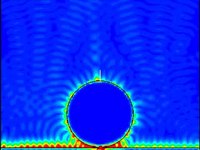
Photo from wikipedia
We present a stable discontinuous Galerkin (DG) method with a perfectly matched layer (PML) for three and two space dimensional linear elastodynamics, in velocity-stress formulation, subject to well-posed linear boundary… Click to show full abstract
We present a stable discontinuous Galerkin (DG) method with a perfectly matched layer (PML) for three and two space dimensional linear elastodynamics, in velocity-stress formulation, subject to well-posed linear boundary conditions. First, we consider the elastodynamics equation, in a cuboidal domain, and derive an unsplit PML truncating the domain using complex coordinate stretching. Leveraging the hyperbolic structure of the underlying system, we construct continuous energy estimates, in the time domain for the elastic wave equation, and in the Laplace space for a sequence of PML model problems, with variations in one, two and three space dimensions, respectively. They correspond to PMLs normal to boundary faces, along edges and in corners. Second, we develop a DG numerical method for the linear elastodynamics equation using physically motivated numerical flux and penalty parameters, which are compatible with all well-posed, internal and external, boundary conditions. When the PML damping vanishes, by construction, our choice of penalty parameters yield an upwind scheme and a discrete energy estimate analogous to the continuous energy estimate. Third, to ensure numerical stability of the discretization when PML damping is present, it is necessary to extend the numerical DG fluxes, and the numerical inter-element and boundary procedures, to the PML auxiliary differential equations. This is crucial for deriving discrete energy estimates analogous to the continuous energy estimates. By combining the DG spatial approximation with the high order ADER time stepping scheme and the accuracy of the PML we obtain an arbitrarily accurate wave propagation solver in the time domain. Numerical experiments are presented in two and three space dimensions corroborating the theoretical results.
Journal Title: Numerische Mathematik
Year Published: 2020
Link to full text (if available)
Share on Social Media: Sign Up to like & get
recommendations!